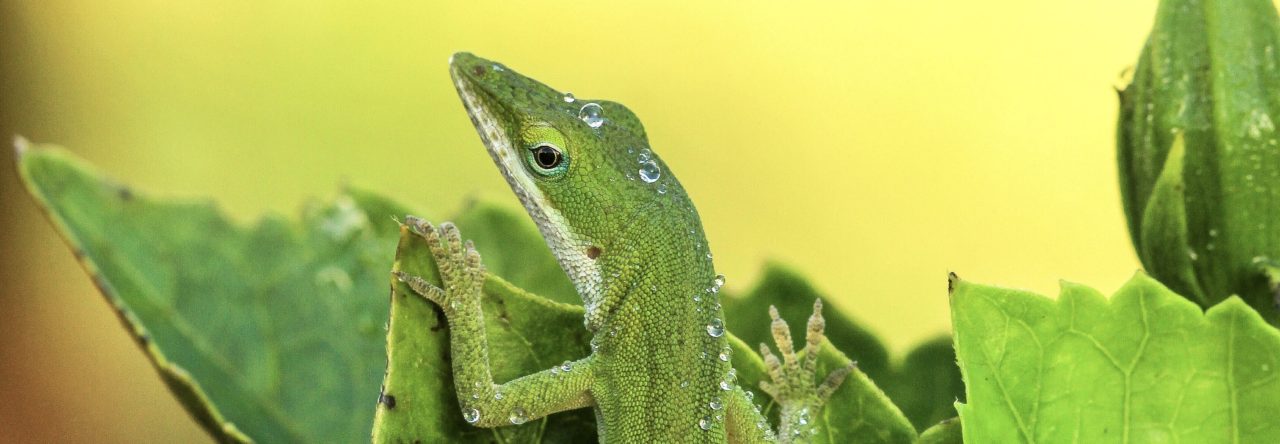Anolis Lizards of the Greater Antilles:
Using Phylogeny to Test Hypotheses
Author: Jennifer (Johnson) Collins
OVERVIEW
STUDENTS “TAKE A TRIP” to the Greater Antilles to figure out how the Anolislizards on the islands might have evolved. They begin by observing the body structures and habitat of different species, then plot this data on a map of the islands to look for patterns in their distribution. From the patterns they observe, students develop alternative hypotheses about how these lizards colonized the islands and evolved. To test their hypotheses, they are given a phylogeny which they color code according to their previous data. By combining both types of data, students make a final hypothesis about how they think the lizards colonized the islands.The objectives of this lesson are to teach students how to:
- 1) Identify patterns in biological data, such as morphological characters (physical features), habitat, and geographical distribution.
- 2) Form multiple evolutionary hypotheses to explain the patterns they observe.
- 3) Test their hypotheses using a provided phylogenetic tree/cladogram.
Terms: distribution, speciation, phylogenetic tree, evolution
Prerequisites:
Before beginning this lesson, students should:
- — Understand that phylogenetic trees (cladograms) are hypotheses of how a set of organisms are related.
- — Be able to read a phylogenetic tree (cladogram).
- — Understand that evolution is change through time. Changes occur through the inheritance of features over many generations.
Time: 70–90 minutes
Grouping: Groups of 2–4 students
Background information: Under development
The webpage includes directions and handouts for both teachers and students.
AA contacted Jennifer Collins to ask how this exercise came to be. Here’s what she had to say:
”
I knew nothing about Anolis lizards before coming across “Darwin’s Lizards” by Jonathan B. Losos and Kevin de Queiroz in Natural History magazine, 12/97–1/98. At the time I was a Teacher on Special Assignment at the UC Berkeley Museum of Paleontology, taking a break from teaching high school biology to expand my horizons. Being surrounded by graduate students and faculty who focused on evolutionary biology, I was thrust into the world of phylogenetics, tree thinking, and other related topics that I had little clue about.
In high school biology classes the only “trees” we dealt with were those we “built” from a simple character matrix of morphological similarities among a selected group of animals. There was a huge dichotomy between how trees were used in research and how K12 students learn about them. So at UCMP, we set out to design ‘What Did T. rex Taste Like?’ to engage students in the utility of trees, rather than the building of trees. That’s when I stumbled upon the Anolis article and got super excited. It focused on really cool characters, was a science story that used trees to test hypotheses generated by morphological and ecological observations, and covered content required in high school biology courses. I wanted recreate the exciting story for students so they could follow in the researchers’ steps. I had fantastic help from folks at UCMP, including Allen Collins, who is now my husband. I have been gratified to hear that the activity has been a success. There is a great need for more activities that focus on how useful trees are. So if you are a researcher with a cool tree story, find an educator to help you turn it into a useful narrative for informing and inspiring the next generation of scientists.”
|
![]() The University of California Museum of Paleontology has a wonderful website on evolution education, including a number of classroom exercises. One of these focuses on using phylogeny to understand the evolution of the Greater Antillean ecomorphs. Here’s the introductory material:
The University of California Museum of Paleontology has a wonderful website on evolution education, including a number of classroom exercises. One of these focuses on using phylogeny to understand the evolution of the Greater Antillean ecomorphs. Here’s the introductory material:

MDO
Thanks for posting – great activity!